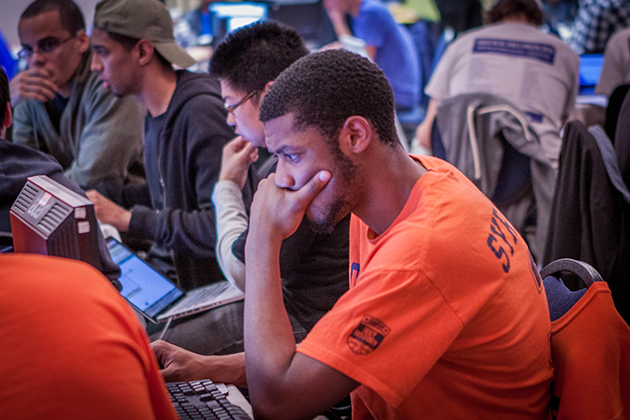First CyberSEED Event Combines Cybersecurity Competition and Discussion
More than 350 people attended the first-ever CyberSEED Cybersecurity, Education & Diversity Challenge, an event that combined expert speakers and three cybersecurity competitions.
The two-day conference took place Oct. 20 and 21 and was organized by the Center of Excellence for Security Innovation (CSI), a partnership between Comcast and the UConn School of Engineering’s Center for Hardware Assurance, Security, and Engineering (CHASE).
“I think we exceeded the expectations in many ways,” said Mark Tehranipoor, Director, Comcast Center of Excellence (CSI). “Because this was the first CyberSEED event for us, we thought ‘Well, we’ll use it as an experience and learn from this.’ But within a couple months, it became clear that we didn’t have time for ‘learning from this.’ We just have to take it to the next level right away.”
The ambitious event brought more than 40 teams from universities across the U.S. to the UConn campus to compete in three unique cybersecurity challenges for more than $100,000 in prizes. The competition played out over the two days in the same venue – the Lewis B. Rome Commons – that hosted some of most respected experts in the field of cybersecurity.
The conference featured more than 20 speakers, including keynote addresses from Rear Admiral David Simpson (ret.), Chief of the Federal Communications Commission’s Public Safety and Homeland Security Bureau; Cheri Caddy, Director for Cybersecurity Policy Integration and Outreach, National Security Staff, The White House; and Donna Dodson, Chief Cyber Security Advisor, NIST.
Speakers and panel discussions addressed a wide range of topics related to cybersecurity – from protecting against international-level cyberattacks, to how businesses can protect their customers. Tehranipoor said he was particularly impressed with the panel discussions that featured all three of the major players in cybersecurity.
“When you bring academia, government and industry into one room and let them talk, I think it’s extremely beneficial,” he said. “The three sides have to hear each other.”
Each is coming at the issue with a slightly different approach, he said, especially in regard to confidentiality. Talking with each other helps resolve those differences.
“At events likes these, they come together and talk about what they want, and I think there’s always ways to come up with common ground,” he said. “I think meeetings like this could have a major impact in the way we address cybersecurity issues.”
The conference also featured a VIP tour of the CSI lab, which opened earlier this year. Tehranipoor and John Chandy, Associate Head of Electrical and Computer Engineering, led guests through the lab and showcased the technology that’s coming out of it.
Sponsors for CyberSEED included Microsoft, Dell, HP, Symantec, CA Technologies, Juniper Networks, Accenture, Veracode, Wipro, PWC and Cyveillance.

